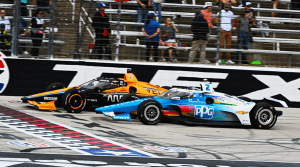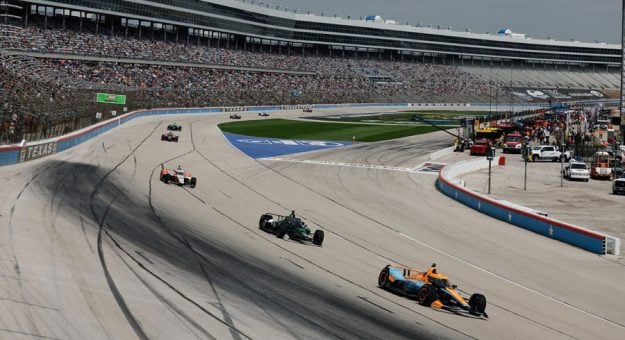FORT WORTH, Texas — One of the best NTT IndyCar Series oval track races in recent years, and the most competitive IndyCar race at Texas Motor Speedway in a very long time, had its share of excitement and controversy.
Early in the race, during the first round of pit stops on lap 51, Alexander Rossi of Arrow McLaren pulled out of his pit box and ran into Kyle Kirkwood’s Honda as the Andretti Autosport driver was pulling into his pit area.
Rossi’s No. 7 Chevrolet sustained suspension damage and a penalty from IndyCar Race Control for “unsafe release from Pit Box.” But penalty was later rescinded in the post-race penalty report and amended in the in the results to a violation of Rule 7.11.1.7 “Contact with another car” in Section 7.11 “Pit Safety Violations.”
According to IndyCar oval procedures, the pit lane is divided into three sections from right to left — an outer lane (commonly known as the “fast lane”), a middle lane (commonly known as the “transition lane”) and, finally, the respective pit boxes.
The fast lane is the lane that should be used when cars are at full speed on the Pit Lane Speed Limiter. The transition lane is the lane that should be used when a car is transiting from to/from its pit box, or when the fast lane is occupied. The priority of cars corresponds with these lanes, with cars in the fast lane receiving the highest priority, car in the transition lane receiving lesser priority, and cars in their pit boxes are entitled to the least priority.
According to IndyCar, “In the case of the No. 7/No. 27 incident, the No. 27 approaching its pit box has a higher priority than the No. 7 leaving its pit box, and thus the No. 7 has a greater responsibility to avoid the contact, according to the above. There is no rule or prescribed period of time or number of pit boxes the No. 27 must utilize the transition lane approaching its pit box.”
Rossi started third and was optimistic he could be in the fight for the race victory.
Instead, he finished 23rd in the 28-car field.
“It got taken away from us in the first stop to no fault of our own,” Rossi said. “It was an inconsistent ruling from IndyCar and very disappointing from Kyle. It was a wasted day for the No. 7 VELO Arrow McLaren Chevrolet, but the car was good and that’s all that matters.”
Later in the race, Kirkwood was called into the pits on lap 107 for an upright issue in the right rear, which Andretti Autosport indicated was unrelated to the earlier incident. The team ultimately decided it was the end of the race for Kirkwood’s car. He finished 27th after starting 20th.
“Unfortunately, our race ended early today,” Kirkwood said. “We made it about 100 laps before we had a right rear upright failure. It was disappointing because we thought we got the No. 27 AutoNation Honda into a good window after that first pit stop. I think we could’ve been right there with Colton Herta and Romain Grosjean fighting for the lead at the end of the race.”

Team Penske’s Josef Newgarden and Arrow McLaren’s Pato O’Ward were locked in a side-by-side battle heading into the final laps, setting up to be a tense finish. But with two laps to go, Grosjean of Andretti Autosport smacked the Turn 2 wall, destroying the No. 28 DHL Honda.
IndyCar officials had no choice but to hit the yellow light and the race ended under caution with Newgarden’s Chevrolet in front of O’Ward’s Chevy. Five-time Texas Motor Speedway winner Scott Dixon of Chip Ganassi Racing finished fifth but accused Grosjean of unsafe driving during the wild battles on the track.
“Grosjean was all over the place,” Dixon said afterwards.
After the crash that brought out the final yellow flag with two laps remaining, Grosjean finished 14th.
“It’s not something you would think you would say, Romain Grosjean winning on an oval, right? But we were up there,” said the former Formula One driver from Switzerland who lived in France. “I was the top guy. Very proud of the effort we’ve made, very proud of the work we’ve done.
“I haven’t seen the footage of what happened, so yeah. We didn’t finish the race. That will happen. We need to start finishing them to … maybe I picked up understeer, maybe David cut a little bit the line to get a good exit, we made contact and that was it. Oh well. Yeah. Bit difficult to digest right now.
“We had a good car. We had a fast car. We were good all the way. So got very unlucky at one point in the race with the traffic and the back markers. But that’s ovals. Couldn’t pass them but apart from that, we had very strong pace.”
It was perhaps the best IndyCar oval race since the wild race at Fontana, Calif., in 2015, but it was not a “Pack Race.” The additional downforce helped the cars run fast laps with an additional lane of racing and the drivers raved at the improvement.
Texas Motor Speedway has a rich and long history of exciting racing with the NTT IndyCar Series, but when the track put the infamous “PJ-1” sealant in 2019. When IndyCar arrived in 2020, the surface was slick and hazardous for the faster-speed racing machines.
It was single-file racing in 2020 and 2021. Last year, then-IndyCar driver and seven-time NASCAR Cup Series champion Jimmie Johnson proved teams could run a higher lane and once rubber worked its way into an upper groove, the racing was better.
But on Sunday, it was spectacular.
According to IndyCar, the PPG 375 had 482 passes for position. That was almost 200 more than last year and 300 more than the average at Texas Motor Speedway since 2018.
The 26 lead changes are the most at Texas since 2001, 26 races ago.
